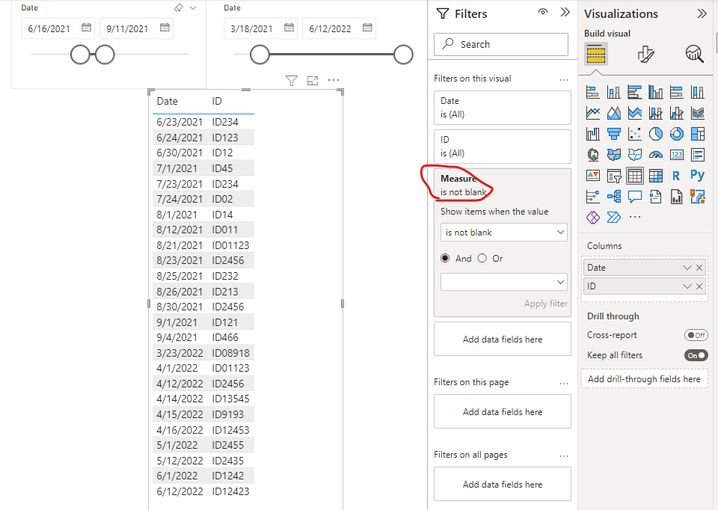Fabric Data Days starts November 4th!
Advance your Data & AI career with 50 days of live learning, dataviz contests, hands-on challenges, study groups & certifications and more!
Get registered- Power BI forums
- Get Help with Power BI
- Desktop
- Service
- Report Server
- Power Query
- Mobile Apps
- Developer
- DAX Commands and Tips
- Custom Visuals Development Discussion
- Health and Life Sciences
- Power BI Spanish forums
- Translated Spanish Desktop
- Training and Consulting
- Instructor Led Training
- Dashboard in a Day for Women, by Women
- Galleries
- Data Stories Gallery
- Themes Gallery
- Contests Gallery
- QuickViz Gallery
- Quick Measures Gallery
- Visual Calculations Gallery
- Notebook Gallery
- Translytical Task Flow Gallery
- TMDL Gallery
- R Script Showcase
- Webinars and Video Gallery
- Ideas
- Custom Visuals Ideas (read-only)
- Issues
- Issues
- Events
- Upcoming Events
Get Fabric Certified for FREE during Fabric Data Days. Don't miss your chance! Request now
- Power BI forums
- Forums
- Get Help with Power BI
- Desktop
- Re: Comparing results from filtering 2 date range ...
- Subscribe to RSS Feed
- Mark Topic as New
- Mark Topic as Read
- Float this Topic for Current User
- Bookmark
- Subscribe
- Printer Friendly Page
- Mark as New
- Bookmark
- Subscribe
- Mute
- Subscribe to RSS Feed
- Permalink
- Report Inappropriate Content
Comparing results from filtering 2 date range filters in the same Dataset
Hi everyone,
I am building up PBI report for my boss (if this task can't get done, I am afraid I would get fired 😅). There's a one dataset A which includes DATE column and ID column inside. The task is I have to build 2 slicers of date ranges using the same DATE column to filter the same ID column in the dataset A and showing a table of all IDs that remove all common IDs between 2 date ranges. I hope you all get what I mean.
My solution is to doubling the date table and the ID table then link the each date table with each ID table. But the problem is now I don't know how to compare the 2 tables to show the common IDs generated when filtering 2 date ranges. Please help me with this issue. If you have other better idea on how to work out it, please guide me through. Thousands thanks to you all!
Solved! Go to Solution.
- Mark as New
- Bookmark
- Subscribe
- Mute
- Subscribe to RSS Feed
- Permalink
- Report Inappropriate Content
Thank you @v-kkf-msft for your support, I have made my own solution. I guess you just don't get what I mean but it's alright. I duplicated the main table twice then use the date in both date in those tables for making slicers. So they don't conflict to each other when filtering. I use one table with unique ID to filter the other 2 duplicated tables.
And the solution loooks like that
- Mark as New
- Bookmark
- Subscribe
- Mute
- Subscribe to RSS Feed
- Permalink
- Report Inappropriate Content
Hi @CamelliaNguyen ,
Please create the following inactive relationship.
Then create the measure to show the items in the visual when it is not blank.
Measure =
VAR Date1_filter =
CALCULATE (
COUNTROWS ( 'Table' ),
USERELATIONSHIP ( 'Date 1'[Date], 'Table'[Date] )
)
VAR Date2_filter =
CALCULATE (
COUNTROWS ( 'Table' ),
USERELATIONSHIP ( 'Date 2'[Date], 'Table'[Date] )
)
RETURN
IF ( Date1_filter + Date2_filter > 0, 1 )
If the problem is still not resolved, please provide detailed error information or the expected result you expect. Let me know immediately, looking forward to your reply.
Best Regards,
Winniz
If this post helps, then please consider Accept it as the solution to help the other members find it more quickly.
- Mark as New
- Bookmark
- Subscribe
- Mute
- Subscribe to RSS Feed
- Permalink
- Report Inappropriate Content
Thank you @v-kkf-msft for your support, I have made my own solution. I guess you just don't get what I mean but it's alright. I duplicated the main table twice then use the date in both date in those tables for making slicers. So they don't conflict to each other when filtering. I use one table with unique ID to filter the other 2 duplicated tables.
And the solution loooks like that
- Mark as New
- Bookmark
- Subscribe
- Mute
- Subscribe to RSS Feed
- Permalink
- Report Inappropriate Content
Hi tamej1, appreciate your support but it doesn't work the way I want it to be mate. I mean Im still unable to combine 2 tables after filtering 2 date ranges to show their different ID between them.
- Mark as New
- Bookmark
- Subscribe
- Mute
- Subscribe to RSS Feed
- Permalink
- Report Inappropriate Content
Hi @CamelliaNguyen
You can build a bridge table between the two fact tables that contains all unique ID's. Then use this table to filter both tables (One to many / One way) relationship. You can simply create a calculated table
ID's =
DISTINCT ( UNION ( VALUES ( Sheet1[ID1] ), VALUES ( Sheet2[ID2] ) ) )Helpful resources

Fabric Data Days
Advance your Data & AI career with 50 days of live learning, contests, hands-on challenges, study groups & certifications and more!

Power BI Monthly Update - October 2025
Check out the October 2025 Power BI update to learn about new features.








